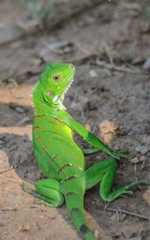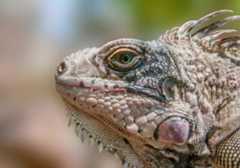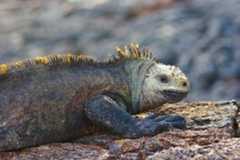iguana
Our editors will review what you’ve submitted and determine whether to revise the article.
- Animal Corner - Iguana – Understanding The Species, Their Features And Habitats
- CORE - Digestion in an Ectothermic Herbivore, the Green Iguana (Iguana iguana): Effect of Food Composition and Body Temperature
- World Animal Foundation - Iguana – Can They Be Kept As Pets?
- WebMD - What to know about Iguanas
- Iguana Specialist Group Virtual Library - The Biology of Iguanine Lizards: Present Status and Future Directions
- LiveScience - Iguana Facts
- A-Z Animals - Iguana
- Vetstreet - Top 10 fun facts about Iguanas
- San Diego Zoo Wildlife Alliance Animals and Plants - Iguana
iguana, any of eightgenera and roughly 30species of the larger members of thelizard familyIguanidae. The nameiguana usually refers only to the members of the subfamily Iguaninae. The best-known species is thecommon, or green, iguana (Iguana iguana), which occurs fromMexico southward to Brazil. Males of this species reach a maximum length of over 2 metres (6.6 feet) and 6 kg (13.2 pounds). It is often seen basking in the sun on the branches of trees overhanging water, into which it will plunge if disturbed. The common iguana is green with dark bands that form rings on the tail; females are grayish green and about half the weight of males. Iguanas also possessatrophied venom glands that produce a weak harmless venom.
Food of the common iguana consists largely of leaves, buds, flowers, and fruits of fig trees (genusFicus), although many other trees are also fed upon. Whereas this lizard has a well-developed digestive system housing bacteria that ferment plant material, it also eats invertebrates when young and has been known to eat small birds and mammals.
During the rainy season, males become territorial, and mating pairs are established. At the end of the rainy season, eggs are fertilized and then laid in clutches of 30 or 50 in the ground during the early dry season. After 70–105 days, the 7.6-cm- (3-inch-) long hatchlings emerge. During this time, eggs and young arevulnerable to predators such ascoatis and other omnivores. Adult iguanas have been used as food by humans for thousands of years and are threatened by hunting andhabitat loss. In rural areas they are a major source of protein.

Other genera include the West Indian iguana (Cyclura) and the desert iguana (Dipsosaurus) of the southwesternUnited States and Mexico. Two genera inhabit theGalapagos Islands: the marine iguana (Amblyrhynchus) and a terrestrial form (Conolophus). The lattergenus includes the pink iguana (C. rosada), which inhabits the slopes of Wolf Volcano onIsabela (Albemarle) Island. All iguanas are egg layers.


















